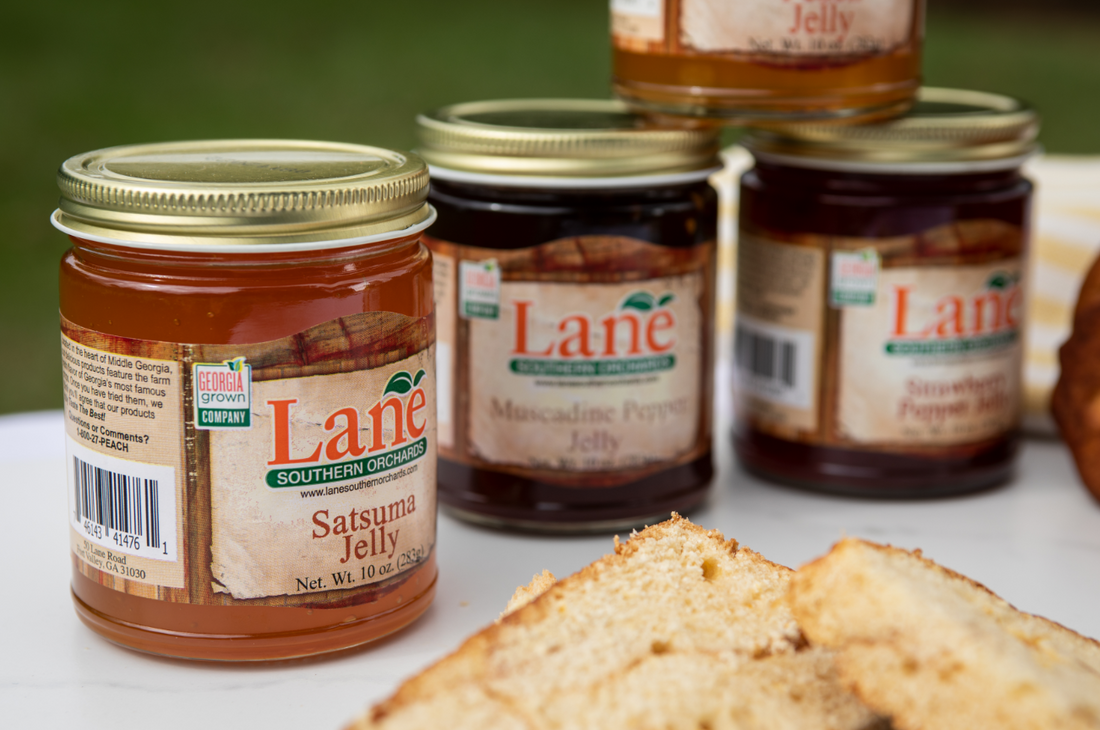The Difference Between Jam, Jelly and Preserves
In normal conversation, “jelly," “jam" and “preserves” are treated as synonyms. At Lane Southern Orchards, though, we know each of these words refers to a distinct, delicious fruit spread with different properties that give it a unique balance and taste. Fresh local fruits go into each one so you can try them in every way imaginable and decide once and for all which spread you need in your home. And we won't blame you if you decide you need all of them!
What's the Difference?
Before we get into the differences between jelly and jam, let's discuss why all these spreads belong in the same family. Jam, jelly and preserves all start with the same basic ingredients — fruit, sugar and pectin.
Fruit, of course, is the base that determines how the final product will taste. Sugar draws out the fruit's sweetness and moisture. How much you add to the mix will determine how smooth or chunky it is, and it will provide shelf stability to the blend. Pectin is a naturally occurring starch found in the skins of many fruits. It's what gives these spreads their sticky, gooey texture.
Jelly is the lightest of the three spreads. It does not contain any fruit particles — its flavor comes exclusively from natural fruit juice. Jelly is generally transparent, so you can see the whole way through the jar.
Jam is a bit chunkier and has a lot more sugar. According to the Food and Drug Administration (FDA), a spread has to be made from at least 55% sugar to classify as a jam. It also uses small fruit particles, giving the spread more texture. It is slightly harder to spread than jelly and not as transparent.
Preserves are the thickest, chunkiest mixture of all. Instead of pieces of fruit like in jam, you'll find slices or even whole fruits in preserves. A good jar of preserves is nearly opaque and more challenging to spread, but just as rewarding when you bite into it.
Although jelly, jam and preserves are the most popular options, there are other spreads that are worth mentioning. Other forms of fruit spreads include:
- Marmalade: This is a type of preserve that uses citrus fruits, including their peels.
- Compote: Compote is a spread classified by its exclusion of pectin in the recipe. Instead, the maker cooks fruit and sugar over low heat for hours until the mixture gels together on its own.
- Conserves: Conserves are a type of jam that uses more than one type of fruit.
- Fruit butter: This is a smooth compote that's been put through a food processor, then cooked down again. According to the FDA, fruit butter is limited to compotes made from apricots, apples, grapes, plums, pears, prunes, peaches and quince.
Making Jam, Jelly and Preserves
The basics of all these spreads are the same. The differences really come from how they're made. Let's look at how these beautiful spreads get their distinctive flavors.
How Is Jelly Made?
The first step to making the perfect jelly is extracting and clarifying the fruit juice. Sometimes, jelly is the preferred option for making particular fruit spreads, like grape spreads, as grapes have small seeds that are challenging to remove.
The juice, pectin and sugar get cooked down. As soon as the maker takes it off the burner, they strain it through a fine strainer or a jelly bag designed for this process. Then, they put the final product in the jar and let it cool until it's the right texture.
How Is Jam Made?
With jam, instead of crushing fruits to extract the juice, the produce gets crushed into smaller pieces and accompanies the juice in the cooking pot. Similar to the jelly cooking process, the mixture is cooked down with lots of sugar and a bit of pectin. Once everything is combined, it cools into a chunky, translucent spread with pieces of pulp floating inside.
How Are Fruit Preserves Made?
As preserves can be made with whole pieces of fruit, sometimes the only necessary preparation is washing them. With bigger fruits, like peaches, the maker may slice the fruits for easier spreading. After the fruit, pectin and sugar mixture is cooked down, it's immediately transferred to a can or jar where it can cool while maintaining maximum flavor and color.
Browse Our Spreads Today
Whichever spread you prefer, Lane Southern Orchards has something to satisfy your tastes. Try our farm-fresh jellies and jams with flavors like peach, blackberry, blueberry and pecan- or pepper-infused blends. Explore our store today to find the perfect addition to your morning toast.
